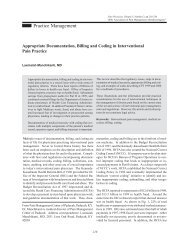ASIPP Practice Guidelines - Pain Physician
ASIPP Practice Guidelines - Pain Physician
ASIPP Practice Guidelines - Pain Physician
You also want an ePaper? Increase the reach of your titles
YUMPU automatically turns print PDFs into web optimized ePapers that Google loves.
Manchikanti et al • <strong>ASIPP</strong> <strong>Practice</strong> <strong>Guidelines</strong><br />
50<br />
Table 8. Results of published reports on effectiveness of facet joint (medial branch)<br />
radiofrequency neurolysis<br />
Study<br />
Study<br />
Characteristics<br />
No. of<br />
Patients<br />
Initial Relief<br />
1-4 Weeks<br />
Long-term Relief<br />
3 Months 6 Months 12 Months<br />
Lord et al (482) P, PC, RA, DB 24 75% 58% 58% 50% P<br />
Van Kleef (503) P, PC, RA, DB 31 67% 60% 47% 47% P<br />
Dreyfuss et al (504) P, C 15 93% 100% 87% 87% P<br />
Gallagher et al (510) P, PC, RA 60 42% NA 24% NA N<br />
C= controlled; P= prospective; RA= randomized; PC= placebo controlled; DB= double blind; NA= not available; P= positive;<br />
N= negative<br />
Results<br />
and both randomized, placebo-controlled, double-blind<br />
studies showed the significant pain relief, along with improvement<br />
in other parameters, indicating strong evidence<br />
from multiple controlled trials. In addition, evidence from<br />
uncontrolled studies also supports the contention that<br />
radiofrequency is effective, even though (contrary to the<br />
popular belief), controlled trials showed better improvement<br />
than uncontrolled studies. Thus, the type and strength<br />
of efficacy evidence for radiofrequency neurotomy in managing<br />
facet joint mediated pain is level II – strong, defined<br />
as evidence from at least one properly designed randomized<br />
controlled trial of appropriate size and high quality or<br />
multiple adequate studies. In addition, in a randomized,<br />
double-blind placebo-controlled trial, Wallis et al (514)<br />
also showed resolution of psychological distress of whiplash<br />
patients following treatment by radiofrequency neurotomy.<br />
Epidural Injections<br />
Approaches available to access the epidural space are interlaminar<br />
(cervical, thoracic, and lumbar), transforaminal<br />
(cervical, thoracic, lumbar, and sacral), and caudal. Epidural<br />
steroid injections are the most commonly used interventional<br />
techniques in pain management clinics. In fact,<br />
the first reports of neural blockade in managing low back<br />
and lower extremity pain secondary to lumbar nerve root<br />
compression were of epidural injections caudally (307-<br />
309). The first administration of epidural steroids was by<br />
transforaminal epidural injections, reported by Robechi and<br />
Capra in 1952 (315), and Lievre et al in 1957 (316). Access<br />
to the lumbar epidural space through a paramedian<br />
approach was proposed by Pages in 1921 (311). Lievre et<br />
al (316) reported their experience with injection of a hydrocortisone<br />
and contrast into the epidural space of 46<br />
patients with sciatica in 1953. They thought that 23 had<br />
good or very good results and 8 had mediocre results; and<br />
the rest were considered failures. The effects of caudal<br />
and interlaminar epidural steroid injections were first reported<br />
independently by Goebert and colleagues (317) and<br />
Brown (515) in 1960. Goebert and colleagues (317) administered<br />
three injections of procaine and hydrocortisone<br />
into the epidural space to 239 patients with sciatica, and<br />
reported greater than 60% relief of symptoms in 58% of<br />
the patients. Since that time, the technique and indications<br />
of epidural steroid injections have been changing constantly.<br />
Numerous reviews have appeared in the literature<br />
evaluating the effectiveness of epidural steroid injections.<br />
The first systematic review of effectiveness of epidural steroid<br />
injections was by Kepes and Duncalf in 1985 (51).<br />
They concluded that the rationale for epidural systemic<br />
steroids was not proven. However, in 1986 Benzon (52),<br />
utilizing the same studies, concluded that mechanical causes<br />
of low back pain, especially those accompanied by signs<br />
of nerve root irritation, may respond to epidural steroid<br />
injections. The difference in the conclusion of Kepes and<br />
Duncalf (51) and Benzon (52) may be due to the fact that<br />
Kepes and Duncalf (51) included studies on systemic steroids<br />
whereas Benzon (52) limited his analysis to studies<br />
on epidural steroid injections only. The debate concerning<br />
the epidural steroid injections is also illustrated by the<br />
recommendations of the Australian National Health and<br />
Medical Research Council Advisory Committee on epidural<br />
steroid injections (47). In this report, Bogduk et al (47)<br />
extensively studied caudal, interlaminar, and transforaminal<br />
epidural injections, including all the literature available<br />
at the time, and concluded that the balance of the published<br />
evidence supports the therapeutic use of caudal epidurals<br />
but does not vindicate it. They also concluded that<br />
the results of lumbar interlaminar epidural steroids strongly<br />
refute the utility of epidural steroids in acute sciatica.<br />
<strong>Pain</strong> <strong>Physician</strong> Vol. 4, No. 1, 2001
















